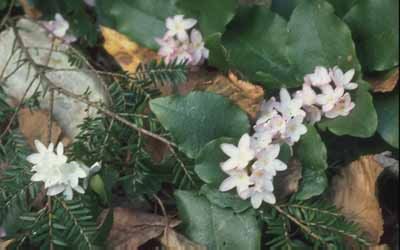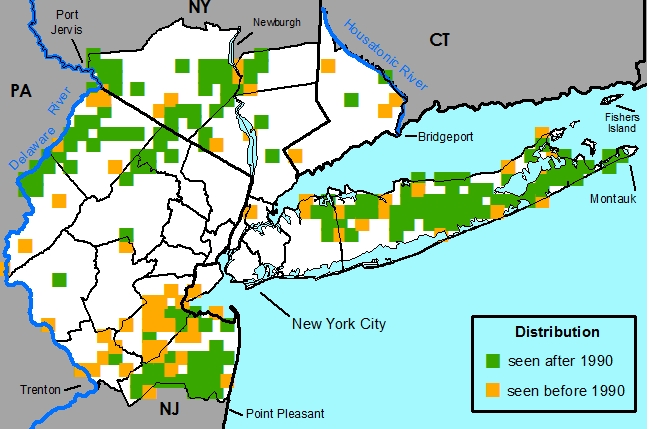Epigaea repens L. - Trailing Arbutus
Common Names
Trailing ArbutusField Identification
A repent subshrub with large ovate leaves and fragrant flowers in the early spring.Medicinal uses
Disclaimer: The information provided here is for reference and historical use. We do not recommend nor do we condone the use of this species for medicinal purposes without first consulting a physician.The dried leaves are slightly astringent and are used as a tonic and diuretic in much the same way as "Uva ursi" and "Chimaphila" are used. An infusion of the herb was used for treating diarrhea in children by the Cherokee.
Common names
Mayflower -- Named by the Pilgrims "who saw in the rise of the new leaves over the brown of last year's foliage a parallel to their own rise over great hardship." (Hussey, 1974).
Trailing Arbutus
Nomenclature
*Epigaea repens L., Sp. Pl. 1: 395. 1753. TYPE: United States. Virginia?: Mitchell? s.n. (Lectotype: LINN 564.1 (IDC 177, f. 317, r. 2, c. 2)), selected by (Reveal, 1987).*Epigaea repens var. rubicunda D. Don ex Sweet, Brit. Fl. Gard. 7: pl. 384. 1837. *Epigaea rubicunda (D. Don ex Sweet) D. Don ex Steud., Nomencl. Bot., ed. 2, 1: 559. 1840, nom. inval. (Art. 34.1c). *Epigaea repens f. rubicunda (D. Don ex Sweet) Rehder, Bibl. Cult. Trees 534. 1949. TYPE: England. Stoke Newington, Collector unknown (raised by Mr. John Milne) (Holotype: CGE? or MW?). [flowers deep red]
*Epigaea repens f. plena Rehder, J. Arnold Arbor. 7: 244. 1926. TYPE: United States. Massachusetts: Hampshire Co., Granby, 12 May 1926, Elbert C. Aldrich s.n. (Holotype: A!). [double flowered]
*Epigaea repens var. glabrifolia Fernald, Rhodora 41: 446. 1939. TYPE: Canada. Nova Scotia: Middleton, 20 Jul 1929, Fernald et al. 22167 (Holotype: GH!). [leaves glabrous]
Description
HABIT perennial, evergreen, hemicryptophyte, subshrubs, autotrophic, monoclinous, with adventitious roots and with fibrous roots, 0.02-0.4 m tall, with rhizomes.STEMS repent, round, not winged, "regular". Prickles absent. Bark furrowed, exfoliating, dark reddish orange or dark gray. Branches ascending or decumbent, dark reddish orange or gray, round, not winged, 1-1.5 mm in diam. Twigs yellowish orange or orange-yellow or orange-red, odoriferous, round, 0.7-1.3 mm in diam., smooth, hairs short and unbranched, erect, multicellular, multiseriate, reddish orange or orange-yellow, dense, throughout, not glabrescent, glands present or without glands, glands at apex of hairs, reddish orange. Pith present, light orange-yellow, round, continuous, nodal diaphragm absent. Thorns absent. Aerial roots absent. Sap translucent. Resin absent.
LEAVES alternate, 1 per node, spaced ± evenly along stem, divergent from stem, simple. Stipules absent. Leaves petiolate, petiole "typical", 0.4-3(-5) cm long, hairs short and unbranched, erect, multicellular, multiseriate, dense, throughout, not glabrescent, glands present, glands at apex of hairs. Leaf: abaxial surface greenish yellow or yellowish green, adaxial surface dark greenish yellow or dark yellowish green, blades ovate or widely ovate, plane, symmetric, 1.5-11.7 cm long, 0.7-5 cm wide, coriaceous, base cordate, margin ciliate, apex acute or apiculate or cuspidate (slightly), abaxial surface hairs short and unbranched, erect, multicellular, multiseriate, dark reddish orange or orange-yellow, sparse, throughout, not glabrescent, glands present or without glands, glands at apex of hairs, reddish orange or orange-yellow, adaxial surface hairs long and unbranched, erect, multicellular, multiseriate, dark reddish orange, moderately dense, throughout, not glabrescent, glands present or without glands, glands at apex of hairs, reddish orange. Brochidodromous venation or reticulodromous venation (somewhat intermediate),veins 5-6. Leaf lobes absent. Spines absent. Tendrils absent.
INFLORESCENCES monomorphic, regular or, if dimorphic, female inflorescence simple, raceme, terminal. Peduncle absent. Rachis present, 0.5-0.7 cm long, with bracts. Bracts sessile, blades: abaxial surface light greenish yellow or dark green, adaxial surface light greenish yellow or dark green, ovate, conduplicate, 0.37-0.57 mm long, 0.16-0.28 mm wide, base cuneate, margin ciliate, apex acute or apiculate, abaxial surface hairs long and unbranched, abaxial hairs erect, multicellular, multiseriate, dark reddish orange, moderately dense, throughout, not glabrescent, glands present or without glands, glands at apex of hairs, dark reddish orange, adaxial surface hairs long and unbranched, erect, multicellular, multiseriate, dark reddish orange, moderately dense, throughout, not glabrescent, glands present or without glands, glands at apex of hairs, dark reddish orange. Pedicel 0 mm long, glabrous, without glands. Bracteoles 2, sessile, at base of pedicel, not connate, bracteoles: abaxial surface light greenish yellow or dark green, bracteole: adaxial surface light greenish yellow or dark green, lanceolate or ovate, plane,4.8-5 mm long, 2-2.5 mm wide, base obtuse, margin entire, apex acuminate. Cupules absent.
FLOWERS serotinous, formed on short shoots, monomorphic, with sepals and petals readily distinguishable from one another, unisexual, flowers red or white or light red, 5-merous, 0.6-1.4 mm long, 0.3-1.1 mm wide, 3-5 flowers per inflorescence, fragrance present, perianth of two whorls. Calyx present, actinomorphic, tubular, of free sepals, persistent, abaxial and adaxial surfaces the same color, light greenish yellow, light along margin, 2.7-7.2 mm long, 3-4 mm wide. Sepals or sepal lobes 5, lanceolate or ovate, 4.5-7.2 mm long, 2-2.5 mm wide, base obtuse, margin entire, apex acuminate, abaxial surface glabrous, without glands, adaxial surface glabrous, without glands. Epicalyx absent. Corolla present, actinomorphic, salverform, of fused petals, deciduous, abaxial and adaxial surfaces the same color, light red or red or white, uniform, 6-13.5 mm long, 3-13.5 mm wide, corolla limb 4-5.5 mm long, 2.9-3 mm wide. Petals or petal lobes 5, "normal", ovate, 3.5-7 mm long, 3-4.2 mm wide, base obtuse, margin entire, apex acute, abaxial surface glabrous, without glands, adaxial surface hairs long and unbranched, erect, multicellular, uniseriate, white, dense, basally, not glabrescent, without glands. Gynoecium syncarpous. Carpels 5. Stigmas 1, capitate. Styles persistent, 1, 3.2-8.1 mm long. Ovary superior, 0.8 mm long, 1.2 mm wide, nectiferous disk present. Locules 5. Placentation axile or parietal. Androecium obdiplostemonous. Stamens 10, 7.8-8.2 mm long. Anthers elongate, opening along the long axis, bithecal, white or light yellow, glabrous. Filaments free, straight, white or light yellow, hairs short and unbranched, erect, unicellular, uniseriate, adnate to corolla tube. Staminodes absent. Male flowers larger than female flowers, present, perianth of two whorls. Calyx present, actinomorphic, of free sepals, persistent, abaxial and adaxial surfaces the same color, sepals or sepal lobes 5, lanceolate or ovate, base obtuse, margin entire, apex acuminate, glabrous, without glands. Epicalyx absent. Corolla present, actinomorphic, salverform(?), of fused petals, deciduous, abaxial and adaxial surfaces the same color, white. Petals or petal lobes 5. Petals or petal lobes, ovate, base obtuse, margin entire, apex acute, glabrous, without glands. Androecium obdiplostemonous, Stamens 9, 7.8-8.2 mm long. Anthers elongate, opening along the long axis, opening entire length of anther, bithecal, light yellow or white, glabrous. Filaments free, straight, light yellow or white, hairs short and unbranched, erect, unicellular, uniseriate, adnate to the corolla lobe. Staminodes absent.
FRUITS septicidal capsule, orange-red, globose, 4-5.5 mm long, 5.3-5.5 mm wide, hairs long and unbranched, erect, multicellular, multiseriate, yellowish orange, dense, throughout, not glabrescent, glands present, glands at apex of hairs, dark yellowish orange, the interior of the fruit is white and fleshy.
SEEDS many, light reddish orange, oblong or subrotund, 0.4-0.6 mm long, 0.4-0.5 mm wide, wingless, not tailed, reticulate-foveate.
Habitat
(Councilman, 1923) (Wherry, 1920) (Wherry, 1920)
Oak and pine woods on sandy or rocky acidic soils, occasionally in rich woods or pond margins. Frequently found with Gaultheria procumbens. Dry upland peat and occasionally moist peat with pH of 4.5-5.5.
Rarity Status
Heritage global rank -- G5Connecticut -- not listed
New Jersey -- not listed
New York -- not listed
Species Biology
FloweringMarch [week 4] - May [week 3].
Pollination
(Clay & Ellstrand 1981) (Ward, 1880) (Weed 1894)Melittophily -- Bumble bees, particularly Bombus bifarius Cr. (but also B. terricola Kby. and B. vagans Sm.), are probably the most important pollinators.
Myrmecophily -- Ants have been proposed as pollinators, but there is no empirical evidence.
Other -- The flowers are visited by a number of other insects including Aglais milberti Godart, Bombylius major L., Hemaris diffinis Boisduval, and Nymphalis antiopa L.
Fruiting
(April [week 3]) May [week 1] - Sep [week 2].
Dispersal
(Blum & Krochmal, 1992) (Clay 1983) (Clay & Ellstrand 1981) (Morrison, 1929)Myrmecochory -- The placental tissue is sweet, and ants often remove portions of the placenta with attached seeds and return them to their nests. Three species were seen doing this: Monomorium cf. minima Buckley, Paratrechina sp., and an unidentified species.
Endozoochory -- It is reported that small game sometimes eat the fruit. Chipmunks are active collectors of the fruit.
Autochory -- It is reported that the seeds are ejected from the dry fruits.
Germination
(Barrows 1936) (Blum & Krochmal, 1992)Germinable -- Requires no pretreatment, but does require ample moisture, high humidity, acid medium, and approximately room temperatures. Germination takes place over a period of 22-66 days.

